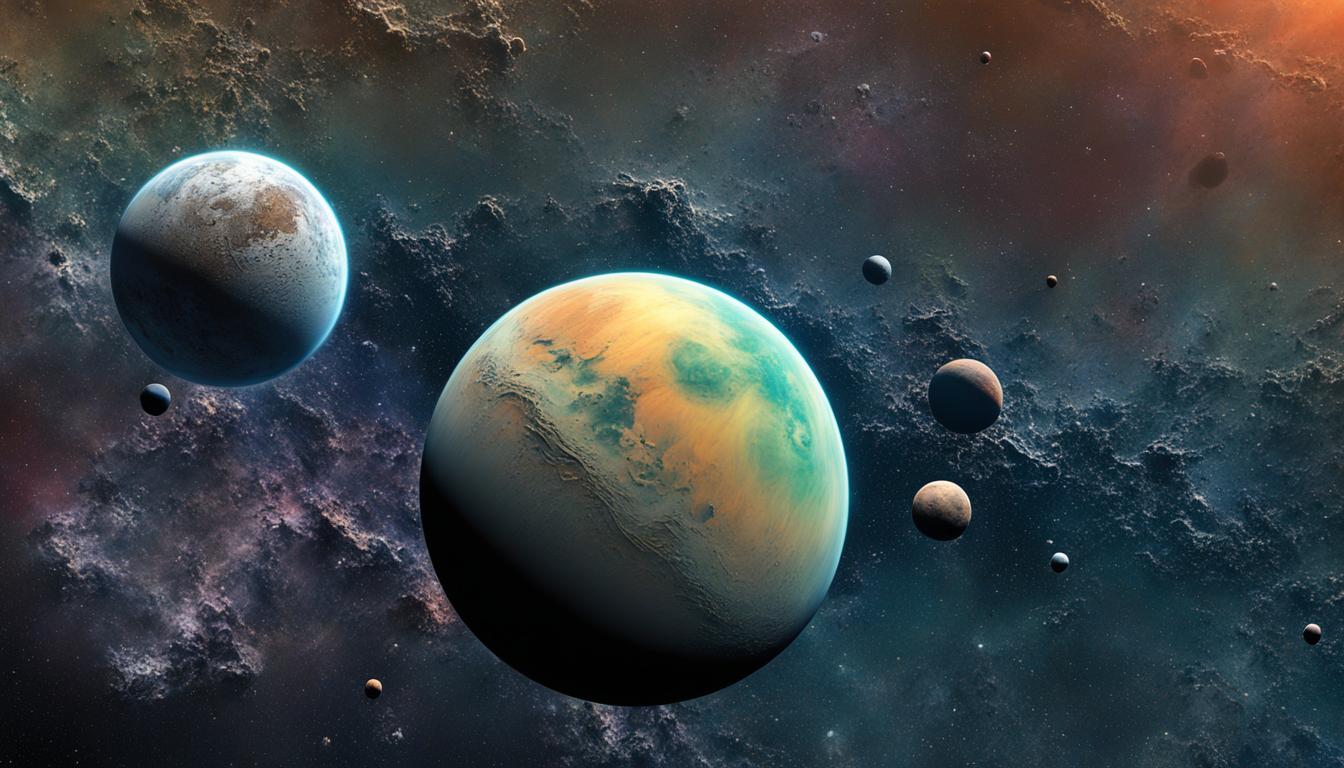Whenever I look at the night sky, I am always amazed by those basically unlimited little dots and what else is in that vast universe. One thing that we don’t see as much as the stars are the other planets, especially the planet types we call exoplanets.
Check out also: Is the Universe Infinite? Exploring Cosmic Limits
With over 5,600 confirmed exoplanets and more than 10,000 candidates waiting, the number is staggering. Each exoplanet could be a world unlike our own yet connected to us in the universe.

NASA thinks the Milky Way has at least 100 billion planets, and some say 200-300 billion. This vast universe is full of possibilities, hinting at many undiscovered worlds. The excitement of exploring exoplanets is in the chance for big discoveries that could change how we see the universe.
Exploring exoplanets tells us stories from far-off stars, kind of like a gateway to an Earth that is different yet the same. It brings us closer to answering a big question: are we alone? Most exoplanets are found using the transit method, and some with the radial velocity method. These methods show us a wide range of planetary systems, some like our own and others beyond our dreams.
What Are Exoplanets?
Exoplanets are planets that orbit stars outside our solar system. This field has grown fast, changing how we see the universe. We sort them into different types by their size and how they move around stars. NASA’s catalog lists five main types: Neptune-like, Super Earths, Gas Giants, Terrestrial planets, and unknown ones. Each type has its own features, making our universe diverse.
Characteristics of Exoplanets
Exoplanets have many different traits that help classify them. For example, Super-Earths are between 1 to 10 times the size of Earth and get denser up to a certain size. Planets bigger than 10 Earth masses are mostly Gas Giants, filled with hydrogen and helium. Hot Jupiters are Gas Giants that orbit very close to their stars.
How Many Exoplanets Are There?
As of July 1, 2024, there are 6,660 confirmed exoplanets in 4,868 planetary systems. 995 systems have more than one planet. Most of these them, 85% of them, are in the tidal locking zone.
NASA has found 5,678 exoplanets, with 4,166 confirmed systems and 10,170 candidates waiting to be checked. It’s interesting that about 1 in 5 stars, like the Sun, have a planet that could support life. Scientists think there could be 11 billion planets like Earth in the Milky Way and up to 40 billion if we include planets around smaller stars.

Exoplanets come in many sizes and masses. For example, Draugr is very light, about as heavy as the Moon. HR 2562 b is much bigger, around 30 times as heavy as Jupiter. These examples show the wide range of planets in our galaxy. Missions like Kepler and TESS have greatly expanded our knowledge, finding over 2,700 confirmed exoplanets.
Notable Exoplanets
Some exoplanets are special because of their unique features or their role in space discovery. The first exoplanet was confirmed in 1992. After that, this sparked a journey to lead us to find 5,502 more exoplanets so far.
For example, TOI-4860 b orbits its star in just 1.52 days, which could be a notable exoplanet. MWC 758 c is special because it was found when its star still had a disk around it.
People all over the world help name these exoplanets, adding cultural value to their names. Spain named one after Hypatia, a famous Greek astronomer, and the U.S. named one after a Cherokee legend.

In Europe, names often come from ancient history and myths, like in Greece and Finland. In Asia-Pacific, Thailand named two exoplanets after local stories.
The way we find themis also interesting. NASA’s TESS mission has found over 320 using the transit method. Future missions like the Nancy Grace Roman Space Telescope and ESA’s ARIEL will likely find thousands more exoplanets.
Methods of Exoplanet Discovery
Astronomers use many clever ways to find distant worlds. They use special methods and techniques to spot these planets. Let’s see some of those most popular and special methods.
Transit Method
Transit photometry is a key way to find them. It works by watching how a star’s brightness changes when a planet passes in front of it. Using this method, NASA’s Kepler mission found thousands of exoplanets, looking at over 150,000 stars. HD 209458 b was the first planet found this way, showing how powerful this method is.
Radial Velocity Method
The radial velocity method, also known as Doppler spectroscopy, finds exoplanets by measuring how stars move. It was the top way to find exoplanets until the Kepler spacecraft took over in 2012. It still works well, finding planets up to 160 light-years away from Earth. The discovery of HD 69830’s planets in 2006 shows how precise and reliable this method is.
Direct Imaging Method
Direct imaging takes pictures of planets by blocking the star’s light. This method captured the first light from an exoplanet with the Spitzer Space Telescope in 2005. It’s hard but gives us a lot of information about the planets.
Gravitational Microlensing Method
Gravitational microlensing uses a star’s gravity to make a distant star’s light bend. This method found OGLE-2005-BLG-390Lb, the most distant known exoplanet, in 2006. It’s an important way to find planets too far away for other methods.
Astrometry Method
Astrometry tracks the precise movements of stars to find planets. It’s important for studying stars and their planets far away. By surveying over a billion stars, ESA’s Gaia mission will find thousands of exoplanets. This shows how powerful astrometric measurements can be.
Current Exoplanet Statistics and Data
The study of exoplanets has grown a lot, making the exoplanet database much bigger. We currently have over 5000 of these mysterious planets in our database, up from less than 50 in 2000.
Number of Confirmed Exoplanets
There are now 5288 confirmed exoplanets, part of a total of 5414 planets. The transit method has found 75% of these planets. The Exoplanet Data Explorer lists 2950 confirmed planets, with 2925 having a well-known orbit. This info helps us better understand our galaxy and is easy to find in the exoplanet database.
Exoplanet Databases and Catalogs
Many databases and catalogs store the latest exoplanet data for scientists and the public. NASA’s Exoplanet Exploration page gives updates on confirmed exoplanets and is a key resource for researchers. The Gaia mission aims to find thousands of new exoplanets close to the Sun. It’s expected to spot about 21,000 exoplanets within 500 parsecs with its precise measurements.
Conclusion
Exoplanets are, in my opinion, amazing things. It’s like looking into one of Earth with different settings and climates and everything else. We always look for life that is similar to us or somehow matches our understanding of life. But depending on these exoplanets, there might be a life that we can’t understand as humans.
Exoplanets open the door to these questions. So when we wonder how many exoplanets are there, we are basically also asking how many alien life out there might be. With over 5,000 exoplanets found so far, the study of these distant worlds is full of possibilities.
For example, the TRAPPIST-1 system, with its seven Earth-like planets, hints at life beyond our planet. We’ve found super-Earths, mini-Neptunes, and super-Jupiters, showing the variety of planets out there. Scientists think there could be 40 billion planets in the Milky Way that might support life.
Our knowledge of exoplanets keeps growing as we seek to learn more. New detection methods and missions will give us deeper insights into these worlds. With confirmed planets on the rise, we could see tens of thousands more in the next decade. The search for exoplanet secrets is just starting, and each new discovery takes us deeper into the universe.
FAQ
What is an exoplanet?
An exoplanet is a planet that orbits a star outside our solar system. These planets can be quite different in size, makeup, and other features.
How many exoplanets have been discovered?
By April 10, 2024, we’ve found 5,602 of them. This is the confirmed number, though. There are thousands more that are still being checked to see if they could be planets.
What are the types of exoplanets?
There are five main types: Neptune-like, Super Earths, Gas Giants, Terrestrial, and unknown ones. Each type has its own special traits that make them interesting.
Which methods are used to discover exoplanets?
Scientists use several ways to find exoplanets. These include the Transit Method, Radial Velocity Method, Direct Imaging, Gravitational Microlensing, and Astrometry. The Transit Method has found the most, with 4,140 discoveries so far.
Where can I find current exoplanet statistics and data?
NASA’s Exoplanet Exploration page is a great place to look. It lists confirmed exoplanets and updates the database often. It’s useful for both research and the public.
What are some key characteristics of exoplanets?
Exoplanets can be rocky, gas-covered, or have other features. They vary in size, temperature, and atmosphere. These differences help us understand if they could support life.
How do exoplanet discoveries impact our understanding of the galaxy?
Finding thousands of exoplanets shows us there are likely many more out there. This research deepens our knowledge of planets and their systems beyond our own.